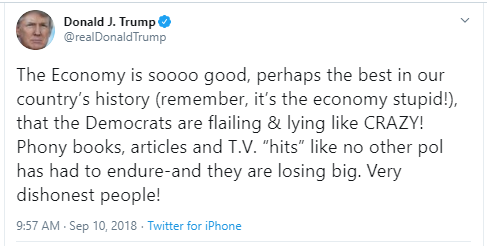Trumps Economic Turnaround or a Solid Ride on Obama's Coat Tails?
This past weekend, president Trump claimed credit for the steady growth and declining unemployment in an attempt to use his perception of the nation's economic gains as an argument to help him get a "win" for his embattled party. Former president Obama was quick to point out that he had handed Trump a strong economy in 2017. So let's take a look at who's lying and who's being truthful here.
In 2018, president Trump tweeted as follows:

1. The economy was NOT struggling when Trump took office.
Trump inherited a booming economy with low unemployment and steady job growth. Of course, before he had taken any actions whatsoever he quickly claimed credit for that. Early in his presidency, Trump boasted about job gains starting from his election onward, crediting Obama's final months as his own. On the other hand, the economy was struggling mightily when president Obama took office in 2009. The economy left from the previous (Bush) administration was in the middle of an 18 month recession. At the time, many people feared the recession would become a depression. Under president Obama's guidance, the economy turned around in the first years of his presidency. In fact, until recently, the US was enjoying its 10th year of economic growth, and the longest period of growth with 95 straight months of job creation -- and most of that happened under the Obama administration.
2. In fairness, Trump should get at least some credit
There have been some impressive numbers during Trump's first term. GDP growth reached 4.2 percent, unemployment was at its lowest point in half a century, and the stock market found new highs. So, some credit is due -- but it's at least partially on the shirt tales of the previous administration.
3. President Obama's administration kept sustained growth throughout most of his 8-year term as president
The last time the GDP last reached 4.2 percent was during Obama's second term. With regard to job creation, Trump's gains still do not match president Obama's. Since Trump took office (up until the COVID-19 crisis), the country added 3.58 million jobs, short of the 3.96 million jobs that were added in the final 19 months of Obama's presidency. While president Obama can look back on an 8-year legacy of sustained growth, president Trump cannot yet make the same argument. And economies are not built overnight.
4. Both presidents drove up the national debt by historic margins
There is a key distinction separating the circumstances behind Trump and Obama's debt figures. Trump inherited an economy undergoing its longest sustained expansion. Obama, on the other hand, entered the White House as the nation veered into a recession that sparked massive stimulus spending and a bailout of the auto industry. Trump was, in effect, buying economic improvements during much of the first three years of his presidency and paying for them with the additional debt that the nation was taking on. Obama was using debt to create economic stimulus -- these are two dramatically different things.
President Trump is now facing a daunting situation. With the COVID-19 crisis having caused significant economic damage, he will be looking to increase the debt, because he will need to do the same thing that president Obama did at the start of his presidency -- to steer the nation out of a deep recession through the creation of economic stimulus. The difference, of course, is that he had already driven the debt up to historic proportions before he even started to bail the economy out of the "Coronacession". As a result, there are not many knobs to turn. The Fed has already dramatically reduced the prime rate to near zero, the nation is heavily in debt already, and we hare a purely Keynesian economy that requires delicate government intervention to avoid the "depression vortex."
This is all factual information that you can check for yourself. I'm not going to draw a conclusion here about who is right and who is wrong. You can do this for yourselves. But facts are facts.




